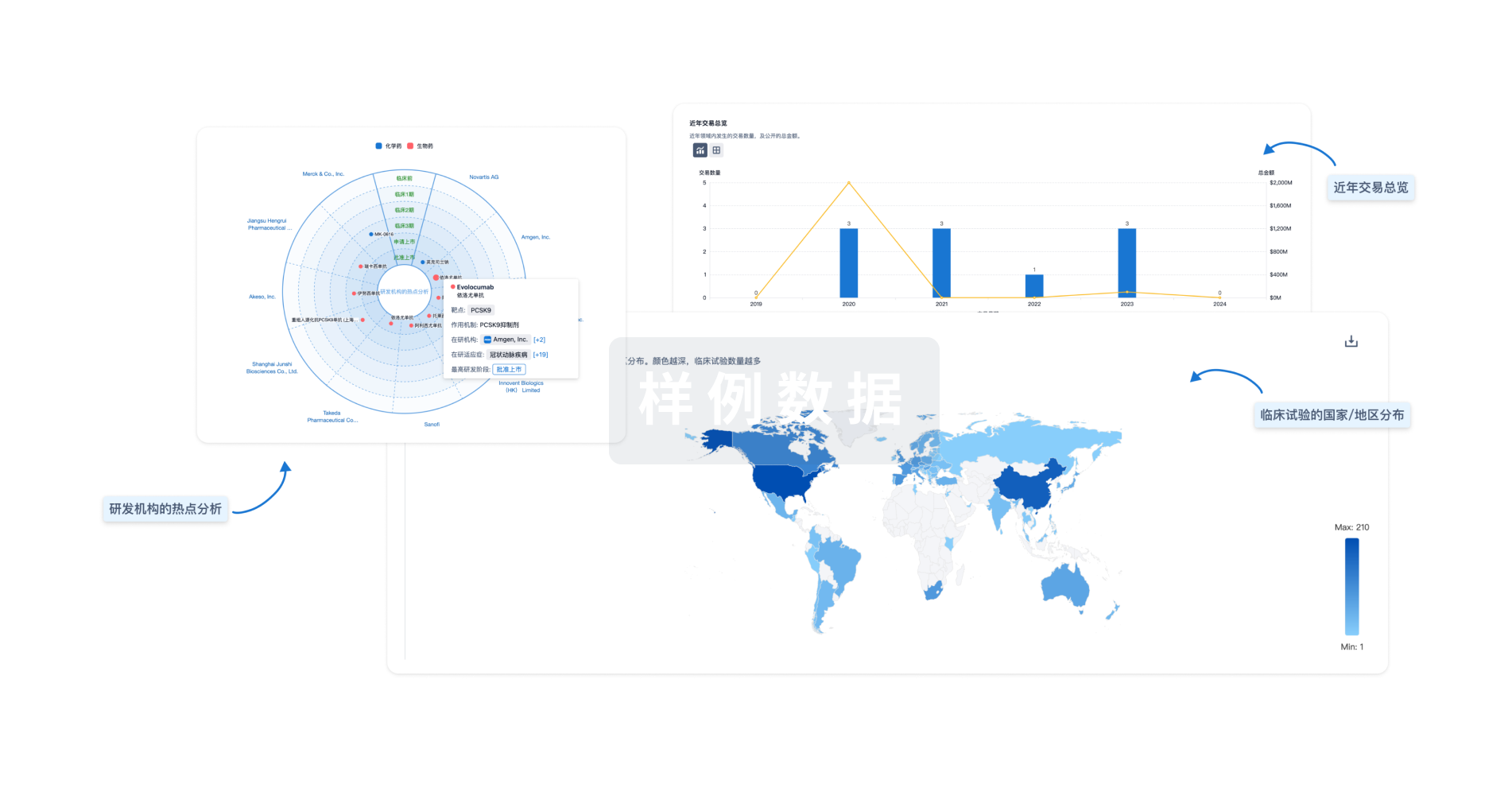预约演示
更新于:2025-05-07
FKBP5
更新于:2025-05-07
基本信息
别名 51 kDa FK506-binding protein、51 kDa FKBP、54 kDa progesterone receptor-associated immunophilin + [17] |
简介 Immunophilin protein with PPIase and co-chaperone activities (PubMed:11350175). Component of unligated steroid receptors heterocomplexes through interaction with heat-shock protein 90 (HSP90). Plays a role in the intracellular trafficking of heterooligomeric forms of steroid hormone receptors maintaining the complex into the cytoplasm when unliganded (PubMed:12538866). Acts as a regulator of Akt/AKT1 activity by promoting the interaction between Akt/AKT1 and PHLPP1, thereby enhancing dephosphorylation and subsequent activation of Akt/AKT1 (PubMed:28147277, PubMed:28363942). Interacts with IKBKE and IKBKB which facilitates IKK complex assembly leading to increased IKBKE and IKBKB kinase activity, NF-kappa-B activation, and IFN production (PubMed:26101251, PubMed:31434731). |
关联
100 项与 FKBP5 相关的临床结果
登录后查看更多信息
100 项与 FKBP5 相关的转化医学
登录后查看更多信息
0 项与 FKBP5 相关的专利(医药)
登录后查看更多信息
1,566
项与 FKBP5 相关的文献(医药)2025-12-31·European Journal of Psychotraumatology
The relationship between childhood trauma, rs1360780 genotypes,
FKBP5
intron 7 methylation and posttraumatic stress disorder in women who have experienced rape
Article
作者: Womersley, Jacqueline Samantha ; Hemmings, Sian Megan Joanne ; Nöthling, Jani ; Mhlongo, Shibe ; Lombard, Carl ; Seedat, Soraya ; Abrahams, Naeemah
2025-12-31·Epigenetics
A polyepigenetic glucocorticoid exposure score and HPA axis-related DNA methylation are associated with gestational epigenetic aging
Article
作者: Appleton, Allison A.
2025-07-01·Journal of Affective Disorders
HPA-axis multilocus genetic interaction with stress life events in predicting changes in adolescent suicidal ideation
Article
作者: Li, Zhihua ; Ren, Menghao ; Zhao, Xian ; He, Zhen ; Zeng, Zihao ; Hu, Yiqiu ; Chang, Mengmeng ; Wang, Dongfang
12
项与 FKBP5 相关的新闻(医药)2025-03-04
·精准药物
研究背景:
临床雄激素受体拮抗剂转化为AR突变驱动的激动剂对前列腺癌(PCa)的治理提出了重大挑战,需要新的抗AR疗法来对抗突变诱导的耐药性。浙大侯廷军教授团队采用基于结构的虚拟筛选和生物学结合的方法,发现了新颖的纯的对AR野生型和AR突变体的拮抗作用的AR拮抗剂。本文选择AR LBD的激动构象进行虚拟筛选,重点研究配体-靶标结合。
研究内容:
与ARLBP高亲和力的Hit化合物E10的发现
首先,对于不同配体的AR LBD晶体结构,对不同精度的Glide评分系统的区分能力进行了评估。对不同预处理的AR配体和诱饵,然后将小分子配体对接到AR晶体结构中,并与晶体结构叠加进行比较。结果表明,对接过程可以准确再现晶体配合物中小分子配体的结合构象。为优化SBVS的效率,通过SP对接、XP对接、药物相似性过滤和结构聚类的级联,从specs化学文库中筛选89种不同结构的化合物。通过竞争配体结合试验初步评估这89个化合物与AR LBD的结合亲和力,在10μM浓度下,E10表现出约为100%的结合亲和力。随后,通过梯度浓度进一步评估E10的结合力,E10与LBD呈剂量依赖性结合,IC50比Enz高0.63μM。E10是一种AR激动剂,使用LNcap-eGFP实验进一步评估了E10对AR转录活性的拮抗活性,E10在一定浓度范围内对AR具有拮抗作用,但随着浓度的进一步增加而下降,而且在缺乏DHT的情况下,E10也促进了AR的转录活性。为了确认E10对携带ART878A突变体的LNCap细胞系的激动作用是否与T878A突变有关,在AR阴性的PC3细胞系中进行双荧光素酶报告基因测定来评估野生型AR的转录活性,在E10浓度较高时,抑制作用逆转为激动作用。在缺乏DHT的情况下,E10也会在微摩尔浓度下刺激ARwt的转录活性,在图1HLNCap细胞中的行为一致。在拮抗模式下,E10作为部分激动剂,在协同模式下,E10作为纯激动剂。
图 1:识别靶向AR LBP的命中化合物E10(PDB ID:3V49)。(A) 已知AR配体和诱饵的Glide SP和XP对接分数分布。(B) 还原AR晶体结构中的原配体。(C) SBVS协议的工作流程。(D) 评估通过SBVS鉴定的89种化合物(10μM)对AR的相对结合亲和力(n=3)。(E) E10的化学结构。(F) 在梯度浓度下测定E10与AR LBP的竞争性结合亲和力(n=3)。(G) 在DHT(5 nM)存在的情况下,E10和Enz对LNCaP eGFP细胞(n=3)AR转录活性的影响。(H) E10和Enz在没有DHT的情况下激活LNCaP-eGFP细胞中的AR(n=3)。1的值定义为10nM DHT诱导的eGFP信号。(I) E10和Enz对DHT(2nM)存在下外源转染ARwt(n=3)的PC3细胞中AR转录活性的影响。(J) E10和Enz在用野生型AR外源转染的PC3细胞中激活AR,不含DHT(n=3)。1的值定义为2nM DHT诱导的荧光信号。
自由能源景观中状态的代表性构象为结构优化提供了重要信息
为了预测E10与AR LBD的动态结合相互作用,进行MD模拟,累计时间600ns,0~100ns的均方根偏差(RMSD)逐渐增加到2.5Å范围,100~600ns稳定在2.2~2.5Å范围。通过对100~600ns的迹线平均1000帧来计算MM-GBSA结合自由能,并进行残差能量分解以标记能量贡献较高的关键残基Leu705、Asn706、Met746和Phe765等13种氨基酸。通过主成分分析(PCA)生成一个自由能图来描述具有代表性的自由能相对较低的构象。S1的能量阱聚集了大量的构象,代表了最低的能量态,化合物E10主要与Leu705和Asn706形成氢键,并与Phe765发生π-π堆积相互作用,同时与AR LBP发生疏水相互作用。S2和S3表现了相对较高的自由能,E10的整体取向保持不变,但两种构象都发生了明显的位移。
图 2:与LBD结合的命中化合物E10的MD模拟(PDB ID:3V49)。(A) E10的RMSD值。(B) AR LBP中的关键残基预计会与E10相互作用。(C) PCA构建的E10自由能景观和代表性构造图。
有人提出由一个仲胺键连接两个芳香环的核心支架。其中胺保存与Asn705形成氢键的能力,同时,在吡啶环上取代或添加向外延伸的LBP口袋的基团。为了从化合物E10的支架中获得有效的拮抗剂,在MD模拟的指导下,在specs和chemDiv库中鉴定出24个E10类似物,然后对化合物进行LNCap-eGFP测定来评估其AR的拮抗活性,其中E15活性最佳,IC50值为0.95μM。随后根据方案1的合成路线,合成了6个以EL15为基础的衍生物。
方案1:化合物EF1-EF6的合成
表1:E10类似物的结构和AR拮抗活性(NA:无活性)
E10类似物EL15和EF2是纯AR拮抗剂
EF2和EF5均表现出良好的AR拮抗活性。IC50值为0.6和0.67μM,而Enz的IC50值为0.14μM。为了排除EL15、EF2和EF5可能的激动作用,在没有雄激素的情况下,使用LNPcap-eGFP测定方法评估这些化合物的反活化作用,在相对浓度大于10μM时,EF5表现出较弱的激动作用,而EL15和EF2均未表现出激动作用。用经过处理的LNCap-eGFP细胞的上清液来测定EL15、EF2,EF5对PSA的抑制活性。EF5对PSA的抑制作用不理想,EF2和EL15表现出明显的剂量依赖性。进一步评估EF2和EL15的靶向能量,这两种化合物与AR均表现出竞争性结合,IC50值为8.53μM和4.79μM,与Enz相当,表明EL15和EF2直接靶向AR的LBP,抑制AR的转录活性,进一步评估EL15和EF2对内源性AR应答基因的调节作用,使用定量PCR评估一组特征明确的雄激素调节基因的转录水平,DHT诱导了三个具有代表性的AR调节基因的mRNA水平,EL15和EF2可以不同程度地显著抑制这种诱导,并呈剂量依赖性。与Enz相比,EF2对KLK3和FKBP5的抑制作用相似,EL15略逊于EF2和Enz。进一步的western blot检测显示,EL15和EF2均能显著抑制内源性PSA,但不抑制AR表达。这些结果支持EL15和EF2对AR信号通路的干预 。
图3 EF2和EL15通过靶向AR LBP干预AR信号通路。(A)在没有DHT的情况下,EL15、EF2和EF5激活LNCaP eGFP细胞中的AR。1的值定义为10nM DHT诱导的eGFP信号(n=3)。(B)通过测量LNCaP-eGFP细胞培养物中分泌的PSA来评估EL15、EF2、EF5和Enz对PSA的抑制作用(n=3)。(C) EL15、EF2和Enz与AR LBP的结合亲和力(n=3)。(D)在10nM DHT存在的情况下,KLK3、TMPRSS2和FKBP5的相对mRNA表达(n=3)。(E) AR和PSA在LNCaP细胞中的表达(n=3)。ns,不显著**与DHT组相比,P<0.01。
EL15和EF2抑制了变异AR突变体的转录活性并且抑制AR阳性细胞系的增殖
本文评估了EL15和EF2对AR拮抗剂耐药性AR突变体。Enz对ARF877L和ARF877L/T878A突变体都表现出明显的转录激动作用,并且单独存在F877L突变相比,T878A和F877L突变同时存在时的效力更强。Bic显著提高了AR的转录活性,而化合物EL15和EF2对ARF877L的转录抑制作用呈现剂量依赖性,充分拮抗ARF877L/T878A突变体的转录活性,对ARW742CEL15,EF2和Enz的效果相似。EL15和EF2对野生型和突变型AR都是有效的AR拮抗剂。为了进一步验证EL15和EF2对AR阳性细胞株增殖的抑制。研究它们对不同特征PCa细胞增殖的影响。EF2在AR阳性PCa细胞系中表现出不同程度的增殖抑制,与雄激素依赖无关,在功效上超过Enz。在雄激素依赖型LNCap细胞和C4-2B细胞中,EF2对细胞增殖的抑制作用呈剂量依赖性,EF15的抑制作用弱于EF2和Enz。在雄激素独立的22Rvl和Vcap细胞中,EL15没有明显活性,而EF2在较高的浓度下仍有一定的抑制作用。对于AR阴性的DU145和PC3细胞,EF2和EL15均表现出与Enz相似的不显著的疗效,表明其选择性抑制AR信号通路。
图 4:EF2在不同阶段阻断AR激活,并且比其他NR更特异于AR。(A) EF2和Enz对DHT诱导的N/C相互作用的抑制作用。用GAL4-LBD、VP16-NTD和GAL4荧光素酶报告基因转染的PC3细胞与1μM测试化合物和10 nM DHT一起孵育24小时。**与DHT组相比,P<0.01。(B) EF2和Enz对DHT诱导的内源性AR核转位的影响(n=3)。将两种提取物中DHT处理组的密度归一化为1**与DHT组相比,P<0.01。EL15和EF2对PR(C)、MR(D)和GR(E)的拮抗活性(n=3)。EL15和EF2对PR(F)、MR(G)和GR(H)的激动活性(n=3)。
EF2阻断DHT诱导的AR N/C相互作用和核转位并且EF2特异性拮抗AR。
本文用暴露于EL15和EF2的人胃上皮细胞的存活率,证明EF2和EL15对AR阳性PCa细胞有特异性活性。EF2阻断DHT诱导的AR N/C相互作用,当缺乏C端组分,N端组分和雄激素任一种时。荧光信号都不能增强,当DHT加入到含有C端和N端组分的样品时,荧光素酶信号增强,分离细胞核和细胞质部分采用western blot分析来确定DHT诱导的AR核易位的影响,EF2和Enz均能显著抑制DHT诱导的AR核易位。相对于GR、MR和PR特异性拮抗AR。
图5:EF2在不同阶段阻断AR激活,并且比其他NR更特异于AR。(A) EF2和Enz对DHT诱导的N/C相互作用的抑制作用。用GAL4-LBD、VP16-NTD和GAL4荧光素酶报告基因转染的PC3细胞与1μM测试化合物和10 nM DHT一起孵育24小时。**与DHT组相比,P<0.01。(B) EF2和Enz对DHT诱导的内源性AR核转位的影响(n=3)。将两种提取物中DHT处理组的密度归一化为1**与DHT组相比,P<0.01。EL15和EF2对PR(C)、MR(D)和GR(E)的拮抗活性(n=3)。EL15和EF2对PR(F)、MR(G)和GR(H)的激动活性(n=3)。
EF2通过氢键和π-π堆积相互作用与AR LBP结合
利用长时间MD模拟,来阐明EF2在AR LBP中的结合构象,EF2非氢原子的均方根偏差在前100ns逐渐增大到2.0~2.5Å范围,在100~600ns保持平衡,从100到600ns之间的MD轨迹中结构和能量分析,突出了13个氨基酸残基,对EF2的结合贡献显著,为了阐明EF2的构象分布在100~600ns的轨迹上进行主成分分析,然后构建了自由能景观,在整个景观的构象空间有两个均匀匹配的能量阱,对比分析结合模式差异很小S2的典型构象缺乏Phe765的π-π叠加效应,S1的代表构象与E10类似。对ARL705A、ARN706A和ARM746A突变体进一步分析,L705A突变将EF2从AR拮抗剂转化为部分激动剂,N706A突变消除了EF2的影响,M746A突变显著降低了EF2的拮抗活性,而Enz保存一致的拮抗活性。
图6:EF2通过氢键和π-π堆叠相互作用的网络与AR LBP结合(PDB ID:3V49)。(A) EF2的RMSD值。(B) AR LBP中的关键残基预计会与EF2相互作用。(C) PCA构建的EF2自由能景观和代表性构象图。(D) EF2和AR LBP之间潜在相互作用的示意图。(E) DHT激活ARwt、ARL705A、ARN706A和ARM746A(n=3)**与其他组相比,P<0.01。(F) 通过萤光素酶报告基因测定法确定Enz和EF2对DHT诱导的ARL705A、ARN706A和ARM746A转录活性的拮抗作用(n=3)。
EF2在C4-2B异种移植小鼠模型中有效抑制肿瘤生长
EF2有效抑制C4-2B异种移植小鼠模型的肿瘤生长,用静脉注射1mg/kg和5mg/kg的剂量灌胃给药分析EF2的药代动力学。结果表明,EF2具有较高的口服生物利益度,但其半衰期相对较短。因此通过灌胃给予EF2每天两次,评估EF2对C4-2B异种移植小鼠CRP肿瘤生长的影响。
表2:EF2的药代动力学参数
在17天的治疗期间,EF2表现出强大的抗肿瘤功效。而且在该剂量的EF2下,没有观察到任何小鼠的明显宿主毒性,在治疗期间体重稳定,用苏术精和伊红染色和免疫组织化学分析,来评估细胞增殖标志物Ki67和细胞凋亡相关蛋白切割-caspase3在对照组和治疗组肿瘤标本中的表达水平,免疫结果表示,EF2降低了Ki67蛋白的表达,同时增加了切割-caspase3的表达。
图7:化合物EF2在C4-2B异种移植物CRPC小鼠模型中的抗肿瘤疗效。(A) C4-2B异种移植物的肿瘤体积变化。小鼠接受50mg/kg剂量的EF2或赋形剂治疗,每天两次通过灌胃给药(n=5)。(B) 治疗期间小鼠的体重(n=5)。(C) 用载体或EF2治疗的肿瘤的H&E染色和免疫组织化学。(D)用赋形剂或EF2治疗的肿瘤中Ki67或Cl-Capase 3水平的定量(n=5)。所有数据均以平均值±SEM表示。**P<0.01。
结论与展望:
在这项研究中,利用AR LBD的激动性构象,进行了SBVS来鉴定对AR LBP的高亲和力化合物。在89个候选化合物中,E10对AR LBP的结合亲和力最高,是Enz的3.5倍。在E10结构和能量分析的指导下,购买并合成30个类似物,其中EF2和EL15是对抗ARwt和各种耐药AR突变体的有效拮抗剂。此外EF2有效阻断DHT诱导,抑制AR下游靶向基因,而且选择性强。通过MD模拟和诱变研究,确认了参与EF2作用的关键氨基酸。此外,体外抗肿瘤实验表明,EF2在C4-2B异种移植CRPC小鼠模型中具有良好的治疗潜力。通过MD模拟引导SBVS选择的高亲和命中化合物的结构优化,发现新的AR拮抗剂。化合物EF2可作为开发PCa新疗法的先导化合物。
作者:欧霞
校审:周金明
编辑:蔡江涛
时间:2025年3月4日
参考文献:Wang H, Wang X, Zhong H, Cai L, Fu W, Chai X, Liao J, Sheng R, Shan L, Xu X, Xu L, Pan P, Hou T, Li D. Discovery of 5‑Nitro‑N‑(3-(trifluoromethyl)phenyl) Pyridin-2-amine as a Novel Pure Androgen Receptor Antagonist against Antiandrogen Resistance. J. Med. Chem,2024, 67(22):20514-20530.
声明:发表/转载本文仅仅是出于传播信息的需要,并不意味着代表本公众号观点或证实其内容的真实性。据此内容作出的任何判断,后果自负。若有侵权,告知必删!
长按关注本公众号
粉丝群/投稿/授权/广告等
请联系公众号助手
觉得本文好看,请点这里↓
临床结果临床1期临床终止
2024-12-16
·精准药物
意义
总结了线性分子如何转化为大环分子的示例。
对线性配体和大环配体及其性质进行直接比较,并分析其背后的分子驱动机制。
基于结构的分析,探讨了当代药物发现过程中线性先导化合物转化为大环分子的关键过渡点。
分析并提供了链连接设计的指南,这是大环优化中的一个重要领域。
引言
大环通常被定义为分子结构中至少包含一个不通过共价桥接的环,且该环含有12个或更多原子的化合物。大自然大量使用大环生成具有生物活性的小分子。这表明,大环能够实现其他分子手段难以达到的性质特征。事实上,许多已批准的大环药物(例如,大环抗感染药物或免疫抑制剂)之所以具有重要作用,正因为它们的大环结构至关重要,因为目前没有非大环类的类似药物具有相似的活性。历史上,大多数临床批准的大环药物都来源于天然产物。然而,过去几十年中,从天然来源发现新活性的大环化合物以满足新靶点需求的速度大大放缓。(1)因此,需要新的方法来挖掘大环的潜力。
大环并不是一个同质的化合物类别:它的定义不仅包括小型药物样化合物(例如,Lorlatinib),还包括分子量远超常规药物空间的夹环肽(例如,ALRN-5281)。鉴于大环的化学多样性,本文聚焦于小型药物样大环的从头设计及其后续优化的努力。我们认为,环肽和天然产物衍生的大环化合物具有显著不同的优势和挑战,这些内容不在本文的讨论范围之内。我们特别关注已发布的药物发现项目中,从“线性”化合物向大环化合物过渡的过程。
由于大环的化学多样性,在文献和化学数据库中系统地查找大环化合物变得更加困难。虽然在数据库中搜索“macrocycle”或“macrocyclic”这样的关键词可以筛选出相关的文献,但要做到更精确的选择(例如,筛选出肽类或金属络合剂)仍然需要手动评估。对于提供结构信息的数据库(例如,http://ligand-expo.rcsb.org/,ChEMBL),可以使用像RDKit这样的工具,搜索包含12个以上原子的环系统(示例代码见附录信息)。作为大环的补充资源,读者还可以参考“Macrocycle DB”数据库(https://macro-db.dpbio.tech/),这是来自济南大学的一个专门收录大环化合物的数据库,截至2024年8月,收录了近18,000个条目。
在过去十年中,美国FDA已批准了七种从头设计的大环药物(见图1)。其中五种针对丙型肝炎病毒(HCV)的NS3/A4蛋白酶,另外两种则针对激酶。纯合成来源的大环药物的临床成功证明了大环的强大潜力可以从第一性原理出发进行从头设计。此外,另外五种大环激酶抑制剂、两种KRAS抑制剂、两种蛋白酶抑制剂和三种MCL1抑制剂目前正在不同阶段的临床试验中(见图2)。
图1. 从头设计的大环抑制剂的FDA批准时间线,包括五种NS3/A4蛋白酶抑制剂(2-6)和两种激酶抑制剂(7和8)。
图2. 从头设计的大环化合物在临床试验中的应用,并与已批准的Lorlatinib(7)和Pacritinib(8)进行结构对比。
大环化合物化的最常见优势包括提高药效、选择性,以及在某些情况下改善ADME性质,包括细胞穿透性。我们通过最新的示例,揭示有利于大环化合物相较于线性分子的趋势和潜在机制。在比较大环分子与“线性”分子时,连接两个(或更多)“线性”分子部分以形成大环的化学基团被称为“连接器”(见图3)。由于连接器是形成大环的关键基团,因此我们在最后部分着重讨论连接器的设计,连接器越来越被认为是调整分子性质的一个额外基团。
图3. 大环化效应的可视化。(A)“线性”配体在溶液中可以采取多种构象。(B)只有一部分溶液中的构象能够有效结合目标。(C)通过连接器将配体的两个远离部分连接起来,可以增加能够有效结合结合口袋的构象比例。
通过大环化提高亲和力和配体效能
大多数小分子在溶液中存在多种构象。当与蛋白质结合时,这种构象通常被称为生物活性构象。然而,并非所有分子都倾向于在溶液中采用生物活性构象,这可能导致在靶点结合时需要付出相当大的能量代价。为了避免这种缺点并提高药物候选分子的亲和力,可以通过构象限制帮助分子固定在特定的构象上,理想情况下是尽可能接近生物活性构象。此时,药物发现过程中需要在两种理想化的情况之间做出选择:第一种情况是溶液中的构象(或构象群)能量低于生物活性构象。这意味着在结合时必须付出由焓驱动的能量代价,这会对最终的结合亲和力产生不利影响。第二种情况是接近生物活性构象的多个低能构象被占据,它们具有相似的能量。通过限制结合过程中可用构象的自由度,可以降低总的结合能量,但这主要是由熵驱动的。这种熵的代价对于灵活分子来说尤其高。实际上,通常存在这两种理想化情况的组合。
大环化是另一种限制和控制分子构象群体的策略。因此,大环化是一种强有力的方法,能够将分子的构象约束和微调,使其尽可能接近生物活性构象,从而提高结合亲和力(见图3)。分子的性质不仅仅是线性类似物和连接器性质的简单相加,而是表现出显著不同的新性质,这些新性质通常优于线性对照物。我们的分析表明,大环化策略通常基于线性分子与其靶标结合的结构信息(例如X射线、NMR或建模)。当分子两部分接近并形成U型或C型生物活性构象时,大环化尤其有吸引力。在大多数研究案例中,分子两端的距离小于10 Å。然而,尽管合成方法随着时间推移有所发展,大环化仍然需要相当大的合成努力。我们观察到,药物研发人员越来越多地收集结构数据,例如通过X射线或NMR结构,并对相关分子在溶液中的构象进行额外分析。这使得大环化过程能更具理性,并且成功率更高。随着化学信息学工具的不断增加,计算化学家在设计有前景的连接器时越来越依赖计算工具。对于一些典型的例子,最终得到的最佳大环也会进行结构和构象分析。这确保了亲和力的潜在提升可以归因于构象控制,而不是由于不同的结合模式或连接器区域与蛋白质的额外接触。
在这个背景下的典型例子是针对第四代突变型EGFR抑制剂的药物发现研究。两个独立的研究小组分别为这个靶标开发了大环化合物,且都使用大环化来进行构象控制。在第一系列(2)中,使用了一套计算与实验相结合的方法,在获得X射线共晶结构后,理解初步线性候选分子的构象群。首先,在真空中计算低能构象,然后进行溶剂化分子的分子动力学模拟。这个数据集进一步通过二维NMR分析进行精细化和验证。尽管分子已经在构象上得到刚性化,但仍然发现了一些与生物活性构象显著不同的低能构象。这一情况特别适合进行大环化,因为生物活性构象也是U型的,且潜在的连接点易于识别。拟议的大环化合物再次通过计算进行构象分析,以确保大环能够采用生物活性构象。预测与生物活性构象最佳重叠的分子随后被合成。最终,最佳的大环化合物相比于非大环化的起始配体,其结合亲和力提高了17倍(见表1,条目1)。在药物发现的第一系列大环化合物中,最常见的连接器类型是简单的烷基链。它们相对易于合成,例如通过环闭重排后再还原双键,但它们表现出相对较高的构象灵活性。尤其是当连接器包含多个重原子时,灵活性可能在构象控制的背景下变得适得其反。即使核心骨架在大环化后可能会被锁定在生物活性姿势中,连接器区域中新引入的过多灵活性也可能会削弱获得的亲和力。这也是在前述第四代EGFR系列中发生的情况,其中通过在连接器部分添加甲基进行刚性化进一步提高了大环化合物的性能。连接器本身在大环设计中变得越来越重要,最后部分总结了一些趋势。在大多数药物发现项目中,通常是在项目的后期才考虑大环化,尤其是在候选分子已经优化并且线性类似物陷入瓶颈时。在许多情况下,这些候选分子已经在构象上受到限制,并表现出有限的分子灵活性。如果预测到不利的构象是导致低亲和力的原因,那么仅通过分析单键旋转就足以识别出问题构象。第二个系列针对同一突变型EGFR受体的第四代治疗面临着类似问题(3)。连接两个环的键的扭曲被认为是问题所在,且进行了更详细的分析。这代表了许多药物化学分子中可能的情况,因为(芳香)环是生物活性分子中的常见结构。在这种情况下,通过量子力学计算对这一结构进行分析并将其从分子其他部分分离出来。计算得出的最低能量两环之间的角度与生物活性构象中的角度不同,且相对能量(约1 kcal/mol)显著提高,这表明构象限制可以避免这一能量代价。事实上,最佳的大环化合物显示出两倍的效能提升(见表1,条目2),尽管在大环化之前的一些结构简化使得直接比较变得困难。
表1. 通过大环化与结构上密切相关的匹配对比(大环与线性类似物)实现亲和力提升的示例,包括大环化后观察到的亲和力增益。
a 这些例子表明,大环化合物的性质并非线性类似物和连接器性质的简单相加。大环化合物中的连接器部分用蓝色表示,且对应线性前体中附着点的位置以蓝点标出。在可能的情况下,提供了与靶标共结晶的化合物的PDB条目。两个原子之间的距离及其对应原子在大环化合物中的位置,都是根据各自的晶体结构计算得出的。
在c-Met抑制剂的开发中,第二个例子表明,对孤立键进行扭转扫描足以揭示不利的构象。再次出现的问题是两个环之间的连接;在这种情况下,它们由两个碳原子连接(表1,条目3)。除(建模的)U型生物活性构象外,这也是大环化策略的主要依据。最佳的大环化合物显示出IC50值的2倍提升(表1,条目3),表明简化的构象分析至少对于那些灵活性较小的候选分子,足以识别潜在的构象弱点。
详细的构象分析往往具有挑战性,并且没有一种通用的方法适用于所有情况。但几乎所有的研究项目都得到了计算方法的支持,如分子动力学或量子力学计算。通过实验方法验证计算数据是有用的,而二维核磁共振(NMR)证明能够提供有意义的结果(2,5)。这一点在一系列BCL6抑制剂的开发中得到了体现,其中一个无环前体被发现更倾向于采用两种构象,而这两种构象都与生物活性构象不同(通过X射线结构确定)。大环化导致抑制剂亲和力提高了100倍以上(表1,条目4)。如预期的那样,环状类似物主要占据了所需的生物活性构象,并且更好地定位了一个重要的相互作用。
除了前面展示的代表性研究外,许多其他药物发现项目最终也通过大环化获得了比线性对照物更强的结合亲和力。我们观察到,设计大环化合物的主要原因是采用U型或C型的生物活性构象,并假设大环化可能为已经走到瓶颈的线性候选分子开辟新的道路。药物研发人员常常认为,有益效果主要归因于正向熵效应,但详细的构象分析往往缺失。实际上,许多因素可以共同促进更好的结合亲和力。根据已展示的案例研究,熵并非总是主要的驱动因素,当采取大环化策略时,进行更复杂的分析是值得的。特别是在优化第一系列大环化合物时,这些化合物通常包含灵活的烷基连接器,进一步的构象分析对于刚性化或修饰连接器可能非常有帮助。然而,表1条目5至条目11中列出的一些成功例子表明,大环化无疑是一种提升结合亲和力的优秀方法。必须记住的是,目前尚不完全清楚或尚未证明为什么在这些案例中大环化是有益的。有趣的是,这些例子涵盖了广泛的靶标,包括PI3Kδ(6)(表1,条目5)或CDK(7)(表1,条目6)、HCV NS3蛋白酶(8)(表1,条目7)、细菌NADK(9)(表1,条目8)、凝血因子XIa(10)(表1,条目9)、BACE(11)(表1,条目10)以及HPK1(12)(表1,条目11)。这表明大环化是一个普遍适用的概念,与特定靶标类别无关,尽管目前大多数先进的大环化合物主要集中在激酶和病毒蛋白酶领域。
除了作为一种特殊的构象控制方法外,大环化在高亲和力化合物的应用或其他附加优势方面也具有特殊的作用。由于连接器通常相对较短(1-6个原子),在上述案例中,可以在不显著增加分子量的情况下提升亲和力。对于能够穿越大脑的药物,低分子量是一个特殊要求,且有时很难在不失去过多亲和力的情况下实现。如果分子同时采用U型生物活性构象,则大环化显得尤其具有吸引力。这一点在前述的BACE抑制剂(11)(表1,条目10)中得到了体现,通过大环化,结合亲和力提升了1到2个数量级。虽然未进行构象分析,但因此例中的主要驱动因素仍然不明。然而,这表明大环化在中枢神经系统应用中相比于线性抑制剂可能具有优势。
另一个优势是连接器部分提供了额外的化学空间。在越来越多的情况下,连接器被利用来精确定位额外的相互作用基团,例如新的氢键形成基团,从而提高结合亲和力。大环化合物具有相对刚性的骨架,可以明确地将附加修饰基团定位在环的周围,包括连接器部分。由于连接器通常位于溶剂暴露区域,远离结合口袋,因此也可以调节远离核心骨架的氨基酸。对于线性类似物,通常很难实现这种定位,除非加入过多的额外原子。这一点在前述的BCL6系列中得到了验证,在大环化合物中,初级醇只能在大环中实现有利定位(5)(表1,条目4)。
除了能够在连接器中引入附加结合基团之外,大环化的凝血因子XIa抑制剂(表1,条目9)展示了这些抑制剂的大环化背景的重要性。同样,大环化的初步依据是U型构象,且未进行详细的构象分析。第一系列大环化合物显示出亲和力显著下降,这是由于连接器与蛋白质的羰基发生空间排斥,导致大环化合物进入了不利的构象。随后,利用羰基与连接器之间的接近关系生成了额外的氢键,从而将分子锁定在更有利的结合构象中。这一效果通过引入一个酰胺功能化连接器实现,显著提升了结合亲和力。有趣的是,无环酰胺功能化类似物并未显示这种效果,因为大环化的连接器对于正确定位酰胺NH是至关重要的。由于连接器相对灵活,因此并不令人惊讶的是,进一步刚性化(如E-烯烃)提高了结合亲和力。与线性类似物相比,结合亲和力提升了令人印象深刻的200倍,展示了大环化在药物发现中的巨大潜力。凝血因子XIa抑制剂的发现过程最终促成了临床候选药物Milvexian(16)的诞生。大环化中连接器部分的设计受到了越来越多的关注,关于先进连接器设计的更多方面和令人兴奋的机会将在连接器部分进行详细讨论。
通过大环化改善选择性
大环化合物通过限制可接近的构象范围,使其接近所需的生物活性构象,这一特性也可以用来增强选择性。本节概述了大环化合物可能提高选择性的四种主要机制。
当配体与靶标蛋白的结合方式与其与不良脱靶(off-target)蛋白的结合方式有显著差异时,大环化可以将配体的可接近构象空间限制在与靶标蛋白结合的区域。这一效应在Farand等人的研究中得到了很好的验证,他们成功地设计了一种大环化抑制剂,显著提高了选择性。(13)该方法基于他们研究中的非大环化前体化合物43(PF 562271)的两种不同结合模式,该化合物与焦点粘附激酶(FAK)和富含脯氨酸的酪氨酸激酶2(Pyk2)共结晶。作者推测,大环化应能去除在FAK结合口袋中观察到的不利构象。结果发现,大环化确实去除了FAK的不利结合模式,同时使得该化合物对Pyk2的结合亲和力提高了175倍,同时将对FAK的结合亲和力降低了2.5倍(图4)。这一效应在文献中较少报道,可能是由于不同蛋白质中可靠结合模式的获取有限。
图4. 大环化去除与不良靶标的结合构象。非大环化激酶抑制剂PF-562271(43)与(A)FAK(PDB: 3BZ3)或(B)Pyk2(大环化位置由紫色箭头指示)(PDB: 5TOB)结合时,呈现出两种不同的结合构象。 (C) 大环化(45)与非大环化(44)FAK/Pyk2抑制剂的直接比较(类似于晶体结构中所示)。 (D) 大环化后,晶体结构显示Pyk2的结合构象与非大环化抑制剂的构象非常相似。
大环化配体的刚性骨架更容易使化学基团与不良结合蛋白的氨基酸发生碰撞。与线性分子相比,大环化合物更为刚性,从而防止配体采取可能避免这些不利相互作用的构象。一个著名的例子是在ALK抑制剂Lorlatinib 7的开发过程中引入了腈基(nitrile)团(14)。通过与其他激酶的比较分析发现,ALK中的Leu1198比其他激酶中对应的氨基酸要小。腈基团深入指向Leu1198,减少了与该位置含较大氨基酸的激酶的结合亲和力。该机制还可用于与其脱靶蛋白相比更为柔性的蛋白质。一个说明这一机制的例子是选择性FKBP51的研究,研究中将氨基酸引入大环化配体,导致酰胺键的羰基与近似同源物FKBP12和FKBP12.6的Asp发生碰撞(15)。虽然靶标蛋白FKBP51能够重新排列以容纳配体,但FKBP12和FKBP12.6则无法如此。这种新的选择性无法通过非大环化类似物实现,突出了大环化骨架的重要性。
与上述选择性增强机制相关,大环化可以导致环张力,从而使配体采用在线性分子中难以获得的构象。例如,芳香环的平面外扭曲预计会显著改善骨形态发生蛋白受体2(BMPR2)和EGFR的两种大环化配体的激酶选择性(16, 17)。这一方法特别适用于具有高度保守结合口袋的脱靶蛋白,例如激酶。上述两个例子突出了分子中即使是微小的化学变化,也能大幅改变选择性谱。表2中比较了大环化和非大环化配体选择性的变化。
表2. 大环化与非大环化配体选择性的变化
a Amrhein等人报道的大环BMPR2抑制剂表现出更好的激酶选择性(17)。选择性得分S35是通过计算抑制的激酶数量占所有测试激酶的比例,且其抑制度低于对照组的35%来得出。选择性得分S(3 μM)是通过计算与所有测试激酶相比,结合亲和力低于3 μM的激酶比例来得出的。连接子部分的附着点以及由此产生的连接子在图中以蓝色突出显示(1920)。
此外,大环化骨架的张力使得分子中更远的部分能够互相连接。大环化骨架的刚性可作为一种杠杆作用,将靶标蛋白与脱靶位点之间的远距离差异转化为重要的相互作用位点。关于AXL选择性配体的一个例子表明,计算研究表明,能够与脱靶蛋白RET最优相互作用的构象由于与更远的配体部分发生空间冲突而无法结合(18)。
上述例子表明,大环化可以通过消除与脱靶蛋白结合的构象、通过使骨架刚性化强迫配体采取能够区分相关蛋白的构象,或者通过利用连接子部分提供的新的分子空间来诱导选择性增强的相互作用,从而提高选择性。特别是在激酶领域,小型大环分子作为高度选择性抑制剂取得了巨大成功。一种可能的原因是大环化能够实现“共识结合模体”(如ATP模拟物)的三维化。
改善ADME性质
某些天然物质(如环孢素A(51))的口服生物利用度出乎意料地好,这可以通过它们能够调整自身构象以适应周围介质来解释(图5A)。以环孢素A为例,其构象灵活性是通过一个酰胺键的顺反异构化实现的,但其他驱动力可能是分子内氢键或芳香环对极性基团的分子内屏蔽作用。该特性(被称为“变色龙性”)的必要但不充分的前提条件是分子的构象灵活性。除了构象灵活性外,假定不同构象之间足够的极性差异也是至关重要的。尤其对于那些不符合经典口服生物利用度标准的配体,变色龙性提供了一个很好的机会,将足够的细胞渗透性与足够的溶解度结合起来。虽然变色龙性的概念不限于大环化化合物,但这一概念在大环化合物类中尤其相关,因为这类化合物往往不符合经典的口服生物利用度标准,因此结合良好的溶解度和渗透性可能具有挑战性。Poongavanam等人今年初对变色龙性概念做出了很好的总结(46)。这一策略的合理利用标志着在开发环孢素A非免疫抑制替代品的药物研发过程中取得了突破。经过优化的领先化合物——源自Sanglifehrin-A的化合物52,虽然显示出非免疫抑制效果,但缺乏细胞渗透性和口服生物利用度(图5B)(21, 22)。改进的关键在于将内酯替换为内酰胺,并引入了喹啉核心(22)。据报道,异环的氮原子在疏水环境中与酰胺形成内部分子氢键,从而增强了渗透性。同时,该大环在极性环境中会采取替代构象,从而使化合物53具有良好的溶解度和口服生物利用度(图5B)。
图5. 超越Ro5的大环化合物中的变色龙性。 (A) 环孢素A(51)能够适应其化学环境,并表现出显著的良好细胞渗透性(有关3D PSA计算的更多信息,见附录)。异构化的酰胺键以品红色高亮显示。 (B) 源自Sanglifehrin-A的小型大环化合物(52和53)因变色龙性而改善了药物性质。
到目前为止,这一现象尚未在从头设计的小分子大环化合物中得到系统性应用。一个可能的原因是缺乏系统性的研究和指导理性设计的模型。为数不多的几项系统性研究之一比较了小分子大环化合物与匹配的非大环化合物的扩散系数。尽管相关的大环化合物一致显示出较高的扩散系数,但作者未能找到令人满意的解释(45)。
最近,科学家们假设,受限的构象灵活性以及分子中疏水和亲水区域的特定空间分布通常有利于渗透性。这一基于4300个大环化合物的渗透性数据分析进一步发展了上述的屏蔽概念,甚至引导作者提出了一种关于如何获得具有高膜渗透性的宏环化合物的通用假设(23)。这些发现具有高度相关性,因为细胞渗透性是化合物口服生物利用度的前提条件。例如,通过分析1000多种非大环的类药物化合物,研究人员发现化合物的口服生物利用度与可旋转键的数量呈负相关,表明更刚性的骨架具有优势(24)。令人惊讶的是,这一效应也出现在分子量超过500 Da的化合物中。这一点对于超越Ro5的分子尤其适用,因为这些分子通常含有许多可旋转的键,且通常具有更高的灵活性。
除了渗透性外,大环化合物化也被认为是改善非大环药物候选分子其他ADME(吸收、分布、代谢、排泄)和药代动力学(PK)特征的可行工具。平均而言,与非大环化物相比,这些药物候选分子可能表现出更好的理化性质,但并非所有问题都能通过大环化解决。然而,在有利情况下,通过连接子对构象进行限制,可以去除分子中的其他部分,同时保持结合亲和力的最小损失。此外,连接子可以通过引入额外的残基来实现所需的性质。ASK1抑制剂(25)的开发展示了大环化如何作为一种工具在先导化合物优化中发挥作用。该项目的目标是优化线性先导化合物Selonsertib 54,以提高其对中枢神经系统(CNS)的穿透能力(图6A)。首先,去除54中溶剂暴露的部分,以最小化外排比率(ER),然后将核心部分进行环化以保持生物活性构象。按照预期,得到的小系列简化大环化合物仍保持对ASK1的亲和力。然后,通过理性设计(系列1)和并行合成(系列2)进一步优化具有最有利药代动力学特征的化合物。最终,系列1和系列2的结合产生了具有低外排比率(ER)和良好CNS可用性的化合物60。
图6. (A) 从Selonsertib (54) 开始的优化过程。 (B) FDA批准的Lorlatinib (7) 开发过程中的主要步骤。
除了获得或保持结合亲和力外,在先导化合物优化过程中,连接子额外的合成把手也可用于微调理化性质,如亲脂性。最具代表性的例子可能是FDA批准的ALK抑制剂Lorlatinib (7)。在优化线性先导化合物的过程中,研究人员确定了中枢神经系统(CNS)活性与测试分子的亲脂性之间的关系,从而确定了理想的LogD和LLE范围(14)。实现这一目标的工具是大环化合物化。首先,具有较高外排比率(ER)的线性化合物61被环化,作为进一步先导优化的起点(图6B)。环化的目的是减少分子灵活性,创建更紧凑的骨架,并提高细胞渗透性。第一代大环化合物通过醚键连接,导致其针对靶激酶的IC50值降至低至两位数纳摩尔(例如化合物62)。用内酰胺连接子替代第一代大环化合物中的醚键,改善了亲脂性谱,形成了更先进的第二代环状化合物。这一系列中的杰出化合物7,后被命名为Lorlatinib,展示了较低的清除率,对ALK突变体具有良好的细胞活性,相较于以前的抑制剂显示出更强的活性,且具有优越的外排比率和CNS暴露,最终于2018年获得FDA批准。
大环分子还可以提供额外的方法来增强代谢稳定性。与线性分子相比,其改善可以有不同的解释。一种假设认为,大环结构通过遮蔽代谢软点,使其无法被代谢酶攻击。然而,识别和合成这些构象受限的大环化合物并非易事。为数不多的几项比较线性与匹配的大环化合物的已发布例子之一是关于因子XIa抑制剂的研究(10)。此前发现的非大环化合物63缺乏效能和代谢稳定性。大环化的目的是主要是预组织生物活性构象(如前所述)。有趣的是,所有大环化合物在人体肝微粒体(HLM)稳定性实验中的半衰期都较其相应的线性参考化合物70更长(图7)。稳定性的差异以及与70的比较支持了构象依赖的代谢稳定性假设(26,27)。
图7. 因子XIa抑制剂的先导化合物优化。通过大环化合物化优化了线性先导化合物,相比于线性参考化合物,优化后的化合物在效能、渗透性和稳定性方面均有显著改善。
另一个有趣但相对少见的应用是利用大环化合物化来掩蔽前药前体。特别是,内酯连接子容易作为酯酶敏感的前药使用。采用(酰氧基)烷氧基连接子的环状双前药,展示了大环化合物在这一应用中的潜力(图8)(28)。通过大环化,线性前体71的正负电荷同时被掩蔽,形成了化合物72和73。这两个大环化合物相比于先导化合物71,表现出显著改善的细胞渗透性。此外,大环化合物73的溶解度较线性参考化合物提高了超过2倍。实验数据显示,化合物72和73迅速转化为所需抑制剂71(在40分钟内转化率超过99%),这一转化确实是由于酯酶水解及连接子后续断裂所致。值得注意的是,无环线性参考化合物74无论在体外还是体内均未转化为71。
图8. 用于凝血酶抑制剂的大环双前药。
总之,大环化合物化被证明是药物化学家在药物发现过程中优化多种参数的有效工具。然而,目前尚无通用的研究或规则能够预测大环化合物可能具有的优异性能。然而,一个反复出现的重要方面是连接化学,它为合成提供了额外的操作途径,能够控制大环化合物的构象,并微调其性质。
连接子设计的进展
通常,最初使用非功能化的烷基链来研究结构骨架与大环化合物化的兼容性,通过变化出口矢量和环的大小。这些连接子,即原始非大环配体的连接点之间的闭环实体,越来越多地用于进一步的衍生化和优化。以下部分提供了几个例子,展示了精心设计的连接子如何进一步改善大环化合物的不同性质。
精心选择的连接子长度对优越的活性至关重要,这在开发大环异柠檬酸脱氢酶2(IDH2)抑制剂时得到了证明。基于已批准的IDH2抑制剂Enasidenib的共晶结构,合成了一系列大环化合物。所安装的饱和和不饱和连接子在长度(6-9个原子)和与苯基部分的连接方式上有所不同。只有引入一个7元饱和烷基连接子才导致活性比线性类似物提高了5倍。相比之下,更长的连接子略微降低了活性,而少一个碳的短连接子则大幅降低了化合物的活性。作者解释称,这是由于之前所描述的化合物在生物活性构象中的锁定。
如果线性起始物已经采用了有利的构象,那么单纯通过刚性化分子本身来增强亲和力的效果则不那么显著。然而,连接子可以作为进一步修改的骨架,最终可能会提升其性质。这一点在开发大环FKBP51抑制剂时得到了说明,对于这种抑制剂,简单的烷基和烯烃连接子与线性参考物相比既没有改善也没有妥协其结合能力。然而,随后引入极性官能团导致结合亲和力显著提高,这很可能是通过促进水介导的氢键的形成。
优化连接子与靶蛋白之间的相互作用是微调大环化合物性质的重要领域。天然产物大环化合物通常不具有药物化学家容易识别为连接子的部分。通常,天然产物的所有部分都具有高度的功能化,并对分子的药理性质做出贡献。其缺点是合成过程复杂,限制了更多衍生物的获得。到目前为止,已经开发出大量金属催化方法,将天然产物启发的结构单元引入合成可得的大环化合物中。这些方法将天然产物的化学空间和高功能化性与合理的合成工作量相结合。
连接子设计还被证明是克服突变易感性的一种工具,这一点在已批准的药物达鲁那韦(Darunavir)中得到了应用。连接子作为骨架与蛋白质主链相互作用,从而实现了与氨基酸的独立性,因为这些氨基酸在突变的蛋白质变体中频繁发生交换。在HIV-1蛋白酶抑制剂的例子中,这是通过在连接子中引入杂原子来实现的。含有柔性苄基醚连接子的抑制剂显示出低纳摩尔级的抑制活性,并且对多个达鲁那韦耐药突变体表现出更高的活性。X射线共晶结构证实了连接子氧与蛋白质主链之间新形成的水介导的氢键。
图9. (A) 大环HIV-1蛋白酶抑制剂的开发。 (B) 化合物76在HIV-1蛋白酶结合口袋中的共晶结构(PDB: 5WLO)。该化合物对达鲁那韦耐药的HIV-1突变株表现出高活性,原因在于连接子氧原子与Asp29和Gly27的主链原子之间形成了额外的水介导氢键(青色,虚线)。
除了与蛋白质主链的亲水相互作用外,连接子部分还可以作为一个平台,诱导新的疏水相互作用。作为大环骨架中的半刚性结构,连接子能够精确地将取代基定位到靶蛋白的特定区域。这一策略在Milvexian(16)开发过程中起到了至关重要的作用,Milvexian是一个临床候选药物,已获得FDA快速通道认证,作为抗凝药物用于治疗缺血性卒中、急性冠脉综合症和房颤。(37)基于12元和13元环状骨架(10),通过系统地修饰连接子上的甲基基团(位置和构型各异),使得它能够进入凝血因子XIa的疏水性结合口袋,从而提高了抑制活性。对分子其他部分的进一步优化最终促成了Milvexian(16,图10)的开发。(38)
图10. Milvexian(16)的开发。连接子设计,包括在不同位置系统地引入甲基基团,是临床候选药物Milvexian开发中的关键部分。
在开发丙型肝炎病毒NS3/A4蛋白酶(39)(图11)抑制剂的过程中,采用了类似的策略,成功地证明了连接子部分在残基定位中的潜力。从一个未功能化的烷基链起步,该链本身就比非大环参考化合物Asunaprevir(77)提高了8倍的活性,随后在连接子上引入了甲基基团。两个甲基基团的相互作用通过调节构象灵活性并增加与蛋白质的疏水相互作用,从而提高了抑制活性(80a)。
图11. 基于Asunaprevir(77)开发的大环HCV NS3/A4蛋白酶抑制剂。引入烷基残基对已发布的大环化合物的抑制活性和代谢稳定性至关重要。
此外,连接子修饰不仅可以增强大环的活性,还可以改善其药代动力学特性。在上述案例中,将其中一个甲基基团替换为体积更大、疏水性更强的乙基基团,有助于提高代谢稳定性和口服生物利用度(81)。为了进一步获得代谢稳定的大环HCV NS3/A4蛋白酶抑制剂,研究人员在连接子中引入了杂原子。然而,这一方法未能成功,只有使用立体位阻较大的gem-二甲基基团才成功得到化合物83,具有100%的口服生物利用度,这相较于使用未取代烷基连接子的化合物82,生物利用度提高了2倍(图12)。(8)
图12. 大环化合物82的药代动力学特性改善。
MCL1是治疗多种癌症的另一具有挑战性的靶点,几种已发布的抑制剂依赖于大环结构(图13)。在开发具有口服生物利用度的MCL1抑制剂AMG176(19)过程中,连接子设计被广泛应用于优化药效和代谢稳定性(图14)。(40)大环化合物89由线性抑制剂发展而来,结构NMR分析其结合模式,为合理的连接子设计提供了指导。受X射线共结晶结构的启发,未功能化的烷基连接子被修饰上了一个羟基、一个甲基基团和一个反式环丁烷环(90)。这些改动通过与靶蛋白形成新的相互作用,使亲和力提高了14倍。进一步通过引入反式烯烃(91)对连接子进行限制,最终增强了亲和力。根据共结晶结构分析和分子建模,这一改进可通过增加生物活性构象的丰度来解释。最后,通过甲基化连接子和羟基基团来提高口服生物利用度,而不损失活性(图14)。
图13. 最近开发的大环MCL1抑制剂。
图14. 从大环化合物89出发,精心的连接子设计帮助开发了临床候选药物AMG176(19)。
AMG176(19)的骨架被用作起点(图15),通过精细调节连接子,进一步改善了ADME/PK特性,同时尽量减少了心脏毒性。(41)最初,连接子中的环丁基部分被换成了四氢呋喃基(THF)残基,以增加极性。尽管19中的环丁基与靶蛋白中的疏水性口袋结合,但更极性的THF环也能良好耐受,因此其亲和力与19相似。为了弥补引入更极性THF环后,细胞活性下降了4倍的情况,研究人员尝试对烯烃部分进行氟化,以提高细胞渗透性(92)。实际上,新引入的氟原子有助于提高亲和力和细胞活性,但未改变这两个参数之间的偏差,表明细胞渗透性未发生变化。为了进一步提高活性,研究人员引入了甲氧基吡唑基磺酰亚胺基团,通过将高能水分子从结合口袋中排除,增加了超过40倍的结合亲和力(93)。除了增强的抑制活性外,极性基团还提高了溶解度和口服生物利用度,并减少了心脏毒性。
图15. 93是AMG176(19)的THF-烯丙基变体,经过改造后兼具高亲和力、细胞内活性及平衡的ADME特性。
由Revolution Medicines开发的分子胶14和15令人印象深刻地展示了“高级连接子改造”的能力。(47,48)这些大环化合物最初来源于天然产物Sanglifehrin A,并经过工程化设计,旨在诱导环孢素A(CypA)与KRas之间的三元复合物。然而,除了CypA核心结合基序外,几乎所有配体的其他部分都发生了改变,包括重新连接的大环骨架(图16)。RAS结合基序可以理解为连接子,在这种情况下,连接子被修改以优化KRas结合,当其处于CypA结合形式时。由此,连接子在大环化合物中的概念在分子胶的背景下获得了新的维度,因为它们是三元复合物诱导活性的关键成分,而这种活性正是分子胶的核心特性。
图16. 大环化合物作为分子胶的骨架。KRas结合分子胶RMC-6236(15)通过重新设计天然产物Sanglifehrin A发现。(A)RMC-6236(品红色)诱导的环孢素A(CypA,绿色)与KRas(小麦色)及GMPNP(青绿色)组成的三元复合物的晶体结构(PDB: 9AX6)。(B) 天然产物Sanglifehrin A(红色)和分子胶RMC-6236(品红色)的CypA结合基序非常相似,并用绿色高亮显示。
即使是在连接子中的化学修饰,也可以诱导与蛋白质的接触,并对大环化合物的三维结构产生重大影响。在VII因子抑制剂的开发过程中,曾开发的抑制剂(94)中芳香族苯基甘氨酸残基部分引入甲基基团,部分导致了抑制活性的增强。这与存在对映异构体(图17)相关。由于两种对映异构体中的一种更有利于蛋白质结合,因此通过计算预测方法,开发了策略来锁定抑制剂在期望的对映异构体构型中。在这种情况下,连接子中引入了一个苯基甲基基团。由此得到的化合物(96)被锁定在有利的对映异构体中,并且引入的甲基基团通过指向疏水性口袋与蛋白质形成了新的相互作用,导致抑制活性提高了16倍。(42)
图17. 在94中引入两个甲基基团将化合物限制为一种有利的对映异构体,从而增强了对VII因子的结合。
对映异构现象在药物开发中可能成为一个严重的问题。开发具有从分钟到天甚至几个月的互变半衰期的对映异构体,可能会面临诸多挑战,原因在于在药物制造和患者给药过程中准确量化对映异构体比例的复杂性,以及确定体内半衰期的难度。(43)为应对野生型和突变型呼吸道合胞病毒(RSV)融合糖蛋白的宏环化合物被描述为存在这一问题,它们以两种对映异构体的形式存在,互变时间在几分钟范围内。通过使用母体烷基连接子作为工具,通过减少对映异构体的互变时间来提高化合物的开发性。最终通过系统性地引入杂原子实现了这一目标,得到了一个16元大环,其具有基于酰胺的连接子,且对映异构体之间的互变时间缩短至秒级。(44)
总结
构象的控制是宏环化合物诸多有益特性背后的关键驱动因素。这包括生物活性构象的预先组织,使得原本不利的构象变得更有利,或排除对于非靶向结合至关重要的构象。此外,宏环化合物的环化过程可以有利于掩盖代谢弱点,并促进分子内部氢键的形成。宏环化合物环化策略的潜在好处在实际应用中,往往被合成工作量的增加和合成通量的降低所抵消。虽然合成挑战可以通过合成方法学的进步逐步克服,但对于非肽类宏环化合物缺乏可靠的预测技术,仍然制约着宏环化合物在药物发现中的更广泛应用。近年来,肽类宏环化合物的计算预测已取得显著进展(49),这表明未来或许也能实现对非肽类宏环化合物的类似精确建模。
目前,启动宏环药物发现项目的最常见策略是基于与线性前体的共晶结构进行的宏环化方法。在这一过程中引入的连接子基团越来越被认为是宏环化合物的重要组成部分,是宏环优化的关键部分。当连接子被埋入结合口袋时,它们可以构成一个骨架,与靶蛋白建立额外的相互作用。相反,当连接子暴露在溶剂中时,它们代表了调节物理化学性质(例如极性)的机会。迄今为止,系统化的连接子设计在许多宏环发现计划中仍然处于较低的关注度。我们预计,连接子将变得更加精细,“连接子学”将在未来的宏环药物开发中成为一个重要组成部分。尤其是在连接子变得更长时,这一点将尤为重要,特别是当从结合模式为C型(相比U型)结合的前体开始时。
参考文献:
https://pubs.acs.org/doi/10.1021/acs.jmedchem.4c01163
2024-11-22
·精准药物
研究背景在该工作中,中国海洋大学秦钟课题组报告了靶向雄激素受体N末端结构域(AR-NTD)的小分子PROTAC化合物,通过连接子将AR-NTD拮抗剂和不同类别的E3连接酶配体栓系而获得。代表性化合物BWA-522有效地诱导AR-FL和AR-V7的降解,并且在体外比相应的拮抗剂更有效地对抗前列腺癌(PC)细胞。其研究结果证明BWA-522降解AR-FL和AR-V7蛋白可以抑制AR下游蛋白的表达并诱导PC细胞凋亡。BWA-522在小鼠中达到40.5%的口服生物利用度,在比格犬中达到69.3%。在LNCaP异种移植模型研究中,BWA-522也被证明是有效的PROTAC降解剂,在口服给药60 mg/kg剂量后,导致76%的肿瘤生长抑制。这项研究表明,BWA-522是一种有前途的AR-NTD PROTAC,用于治疗AR-FL和AR-V7依赖性肿瘤。 图1 前列腺癌(PC)是最常见的恶性肿瘤之一,在男性中发病率和死亡率都很高,全球有超过1000万男性患病,每年全球有超过40万人死亡。在早期阶段,PC可通过放射治疗或手术缓解,而接受雄激素剥夺疗法(ADT)治疗晚期PC的患者最终获得致死性去势抵抗性前列腺癌(CRPC),这通常与雄激素受体(AR)转录增加有关。AR及其持续的下游信号传导对于PC细胞的生长、存活和增殖至关重要。野生型全长AR基因由8个外显子和内含子组成,其形成C末端配体结合结构域(LBD)、铰链、DNA结合结构域(DBD)和N末端转录结构域(NTD)的编码序列,(图2A)。此外,AR基因突变主要由AR-LBD和剪接变体(ARV)上的特定点突变组成。AR-V7,缺乏LBD和铰链区,是最广泛表征的AR剪接变体,并被鉴定为能够显著促进CRPC中AR调节基因表达的主要雄激素非依赖性驱动因子。大多数FDA批准的AR拮抗剂(图1B),如氟替卡松(1)、比卡鲁胺(2)、恩杂鲁胺(3)和阿帕鲁胺(4),通过竞争性抑制雄激素靶向AR-LBD。然而,LBD中的点突变和AR变体中完整LBD的缺失导致对这些拮抗剂的原发性或获得性耐药性。近年来,也报道了一些针对其他AR结构域的拮抗剂。据报道,化合物5是一种有效的AR-DBD拮抗剂,在AR转录活性中的IC50= 0.1μM。Sadar等人报道,EPI化合物是从海绵中分离的双酚A衍生物,并发现通过抑制NTD的AF-1结构域来阻止AR转录活性。EPI-002(6)是一种有效的AR-NTD拮抗剂,及其乙酸酯前药EPI-506(7)于2015年进入I期临床试验,但其效力不足且代谢特性较差,限制了其进一步的临床试验。EPI-7386是EPI家族化合物中的另一种AR-NTD拮抗剂,化学结构未公开,于2020年进入I期临床试验。
图2:(A)AR的结构和AR基因突变。(B)靶向LBD、DBD和NTD的AR拮抗剂的结构蛋白水解靶向嵌合体(PROTAC)是一种有前景的治疗策略,其通过劫持细胞泛素-蛋白酶体系统来诱导靶蛋白的泛素化,随后通过蛋白酶体降解。(图3)与传统的小分子抑制剂相比,PROTAC具有显著的优势,包括它们治疗“无法控制的目标”的能力并通过以较低剂量和毒性消除病原蛋白质来避免耐药性。Crews等人报道了第一个AR-PROTAC降解剂(8),其设计基于MDM 2作为E3连接酶。为了改善AR降解活性和药代动力学(PK)特征,Arvinas的科学家采用有效的AR拮抗剂作为配体,沙利度胺衍生物作为(CRBN)配体,并将它们与有利的刚性接头连接以获得ARV-110(9),其是在所有测试的细胞系中具有低纳摩尔水平的DC50值的口服生物可利用的AR- PROTAC。ARV-110是2019年第一个进入I期临床试验的AR- PROTAC降解剂,目前正在II期临床试验中进行评估。Wang等人随后报告两个系列的基于CRBN、ARD-2128(10)和ARD-2585(11)的有效口服AR- PROTAC在小鼠中的口服生物利用度分别为67%和51%。虽然已经开发了许多AR-LBD PROTAC,成功实现了AR的降解,但这些PROTAC靶向AR变体(如缺乏LBD的AR-V7)仍具有挑战性。MTX-23(12)是第一种AR-DBD靶向PROTAC化合物,据报道可有效降解全长AR(AR-FL)和AR-V7,DC 50值分别为2和0.37 μM。该课题组的研究组最近报道了含有AR拮抗剂、连接子以及能够诱导AR-FL和AR-V7降解的Hsp 90结合基序。假设靶向AR-NTD的PROTAC应能够同时降解AR-FL和AR-V7,并将在PC和CRPC治疗中显示出临床价值。在此,该课题组报告了第一例AR-NTD靶向PROTAC的设计、合成和生物学评价研究,发现了一种新型的口服活性AR-FL和AR-V7 PROTAC降解剂BWA-522。
图3:代表性AR PROTAC的化学结构研究内容
AR-NTD PROTAC是异双功能分子,通常由三种组分组成:结合AR-NTD蛋白的配体、募集E3连接酶复合物的第二配体和将这些配体连接在一起的接头(图4A).由于E3连接酶,VHL和CRBN已成功用于PROTAC的设计,该课题组选择了它们相应的配体来募集AR-NTD PROTAC中的E3连接酶(图4B)。
图4.(A)含有AR-NTD配体和E3连接酶配体的AR-NTD PROTAC的一般方案(B)VHL配体和CRBN配体的结构作为一种有前景的小分子AR-NTD拮抗剂,EPI-002被认为与NTD AF-1区域共价结合(图5)。首先,EPI-002氯代醇子结构的仲醇通过快速可逆的相互作用位于NTD AF-1碱性位点附近。随后,碱位点从仲醇中除去质子,导致形成亲电子环氧化物。反应性环氧化物最终与NTD AF-1中的亲核位点反应形成共价键。因此,该课题组认为EPI-002的溶剂暴露的丙二醇亚结构可以是通过适当的接头掺入E3连接酶配体而不显著降低对NTD的结合亲和力的合适位点。
图5:EPI-002与NTD AF-1区共价结合反应的提出机制 使用含叠氮化物的VHL配体和含炔的EPI-002衍生物之间的点击反应,该课题组设计并合成了三种具有不同长度接头的潜在AR-NTD PROTAC(13−15)。在AR依赖性细胞系LNCaP和VCaP中通过蛋白质印迹法评价PROTAC的AR-FL降解。同时,还测试了它们在高水平表达AR-V7的VCaP细胞中降解AR-V7的能力。通过灰度分析定量AR-FL和AR-V7蛋白水平,提供表1中总结的数据。数据显示,基于E3连接酶VHL的化合物13 - 15在两种PC细胞系中的浓度为1和5μM时,仅具有将AR-FL降低17.6 - 53.5%的适度能力。然而,这些化合物都成功地将VCaP细胞中的AR-V7降低了38.1 - 63.3%。总之,这些结果表明,AR-NTD PROTAC具有开发为AR-FL和AR-V7双降解剂的潜力。
表1:VHL配体与柔性连接体的连接体亲和性研究该课题组质疑CRBN配体是否可以用于设计AR-NTD PROTAC。首先是确定柔性接头中的接头长度是否对AR降解活性有显著影响,该课题组继续使用点击反应合成具有脂肪烃接头和聚(乙二醇)(PEG)接头的化合物16 - 21(表2)。Western印迹显示,这些化合物在LNCaP细胞中仅轻微降解AR-FL蛋白,但有效地降低VCaP细胞中的AR-V7蛋白。在5μM下,具有最短连接体长度(10个原子)的化合物16使AR-V7中度降低64.1%。在连接体长度为11−14个原子的化合物17−20中,AR-V7的降解水平没有显著改善。具有12个原子连接基的化合物18在1和5μM下分别使AR-V7减少62.2%和71.1%。随着连接体长度延伸至13(19)和14个原子(20),降解活性略微降低,并且与18 - 20相比,含有PEG连接体的化合物21在VCaP细胞中显示出降低的降解活性。接下来,该课题组合成了化合物22 - 24(表2),引入带有哌啶基团的半刚性连接体来限制构象并提高溶解度。在以5μM浓度给药的这些化合物中,随着连接体长度的延长,观察到AR-V7降解水平呈增加趋势。含有10个原子的连接体的化合物24显示出最有效的降解活性,在LNCaP细胞中,1和5μM的浓度分别使AR-FL降低21.2%和39.1%。此外,在VCaP细胞中,在1和5μM下,它使AR-FL显著降低22.6%和49.3%,使AR-V7显著降低54.4%和75.7%。
表2:柔性和半刚性连接基CRBN配体的连接基稳定性研究连接体的构象限制有助于形成稳定且高产的三元复合物,从而显著提高化合物的降解活性。因此,该课题组合成了化合物25 - 34(表3),其中使用了刚性越来越大的连接体,如四元或六元杂环,以限制化合物的构象。虽然这些化合物中的大多数未能降解LNCaP细胞中的AR-FL,但化合物28(BWA-522)在1和5μM下使AR-FL降低了48.7%和72.0%。在VCaP细胞中,化合物25 - 27(在连接体中有两个杂环)使AR-FL轻微降低<40%,使AR-V7中度降低43.6 - 69.9%。类似地,通过将化合物27中的连接体延长一个亚甲基获得的BWA-522显示出最强的AR-FL和AR-V7降解活性,在1和5μM下分别将AR-FL有效降低52.4%和73.1%,将AR-V7有效降低77.3%和84.6%。化合物29−32在其连接基中含有三个杂环,在1和5μ M下保持有效的降解活性,使AR-FL水平降低62.5%,AR-V7水平降低29.2− 80.3%。然而,观察到化合物31和32在5μM时诱导细胞死亡。在22 Rv 1和PC-3细胞中评价了不同浓度的化合物31和32对AR-FL和AR-V7的降解作用。结果表明,31和32在低浓度(0.03−1μM)下不能诱导AR-FL和AR-V7降解,但在高浓度下导致细胞死亡。此外,化合物31和32显著抑制AR非依赖性PC-3细胞生长,IC50值分别为1.03和1.37μM。这些结果表明,化合物31和32显示出脱靶细胞毒性。化合物33和34(在接头中含有三个环和一个酰胺基团)使VCaP细胞中的AR-FL和AR-V7水平降低<50%,其效力低于化合物BWA-522。
表3:不同刚性连接体对AR-NTD PROTAC影响的研究最后,由于使用刚性连接体后降解活性的提高,通过将化合物25 - 34中沙利度胺苯环的连接位置从间位改变为邻位,合成了化合物35 - 44(表4)。Western印迹显示,这些化合物中的大多数在降低LNCaP细胞中的AR-FL蛋白水平方面上级相应的间位取代化合物。此外,它们在VCaP细胞中对AR-FL和AR-V 7保持相同的降解活性。在LNCaP细胞中,化合物39在1和5μM时分别使AR-FL降低13.9%和62.4%,并且是化合物35 - 44中最有效的AR-FL和AR-V7降解剂。在VCaP细胞中,1μM和5μM的AR-FL进一步有效降低44.3%和51.2%,AR-V7降低37.1%和72.7%。与化合物31和32类似,化合物41和42在5μM时显示出细胞毒性。尽管化合物43相对于化合物33改善了LNCaP细胞中AR降解的能力,但未观察到其在VCaP细胞中具有任何降解效力。化合物44在降低两种细胞中的AR-FL和AR-V7水平方面比34有效得多。
表4:不同刚性连接体对AR-NTD PROTAC影响的研究基于AR-FL或AR-V7在LNCaP和VCaP细胞系中的明确降解活性,该课题组评估了三种代表性化合物(24、BWA-522和39)在小鼠中的PK(表5和图6)。以2 mg/kg静脉内给药后,化合物24、BWA-522和39具有不同的半衰期(t1/2 = 0.5、8.2和13.6 h)和最大浓度(Cmax = 518、782和662 ng/mL)。化合物BWA-522达到了最高的最大浓度(图6A),这反映了高血浆暴露(AUC值= 3018 h·ng/mL)。BWA-522具有594 mL/h/kg的低血浆清除率,而化合物24和39的血浆清除率为6636和2314 mL/h/kg。还比较了10 mg/kg剂量的三种化合物的口服给药,发现化合物24、BWA-522和39也具有不同的半衰期(t1/2 = 1.8、7.9和20.5 h),达到最大浓度的时间(tmax = 0.2、4.7和2.0 h)和最大浓度(Cmax = 130、376和47 ng/ mL)。化合物BWA-522具有优异的口服血浆暴露,AUC值为5947 h·ng/mL(图6B),这比24(图6A)或39(图6C)好得多。此外,化合物BWA-522的口服生物利用度为40.5%,而化合物24和39的口服生物利用度分别仅为7.8%和12.3%。鉴于BWA-522在小鼠中的良好口服利用度,进一步评估了其在比格犬中的PK(表6)。当以5 mg/kg的剂量口服给药时,BWA-522的t1/2较长,为31.2 h,口服生物利用度较高,为69%。这些结果共同表明,BWA-522是一种口服活性PROTAC降解剂。
表5:化合物24、BWA-522和39在小鼠体内的PK
图6:小鼠血浆浓度-时间曲线
表6:化合物BWA-522在比格犬中的PK基于在LNCaP和VCaP细胞中的初步筛选和PK谱,选择BWA-522用于用蛋白质印迹法进一步评估其降解能力。使用三种PC细胞系LNCaP、VCaP和22 Rv 1测定BWA-522的效力。在这些细胞中,22 Rv 1是一种CRPC细胞系,据报道其对AR拮抗剂恩杂鲁胺具有耐药性。BWA-522显著降低了三种细胞系中AR-FL或AR-V7的水平。它在最初的3小时间隔有效地降低了LNCaP细胞中的AR-FL水平,并产生了持续的降低直到24小时,但AR-FL在48小时内反弹(图7A)。值得注意的是,在VCaP和22 Rv 1细胞中,AR-V7的降解效果比AR-FL的降解效果更显著(图7 B、C)。数据表明,BWA-522还以剂量依赖性方式诱导AR-FL和AR-V7蛋白降解(图7A-C)。处理24小时后,BWA-522在三种细胞系中有效地将AR-FL和AR-V7从0.03μM降低到30μM。在高达30μM的浓度下,未观察到BWA 522的钩状效应。BWA-522在LNCaP、VCaP和22 Rv 1细胞中诱导AR-FL蛋白降解,DC 50值分别为3.45、0.73和2.41μM(图7D)。它还在VCaP和22 Rv 1细胞中实现了有效的AR-V7蛋白降解,DC50值分别为0.67和0.76μM(图7E)。与结构-降解关系研究一致。
图7:(A-C)LNCaP、VCaP和22 Rv 1细胞中AR-FL和AR-V7蛋白的蛋白质印迹分析。D,E)基于PC细胞系中归一化为α-微管蛋白水平的AR-FL和AR-V7水平的定量的BWA-522的DC50值 该课题组发现在同一细胞系中,相对于比AR-FL蛋白的降解,BWA-522更有效地诱导AR-V7蛋白降解,接下来研究BWA-522在PC细胞系中的降解机制。10μM BWA-522处理10 h后,VCaP和22 Rv 1细胞中的AR-FL和AR-V7被有效地降低。当在BWA-522处理前用蛋白酶体抑制剂MG132(3μM)、活化E1酶抑制剂MLN4924(1μM)和CRBN配体沙利度胺(100μM)预处理细胞时,降解效应显著阻断(图8)。这些机制数据充分证实了BWA-522对AR-FL和AR-V7的降解依赖于泛素蛋白酶体系统和CRBN泛素连接酶。
图8:BWA-522降解AR-FL和AR-V7的作用机制
AR及其变体在调节AR依赖性PC细胞的增殖中至关重要,因此接下来使用EPI-002(5)作为AR拮抗剂对照,在LNCaP、VCaP和22 Rv1细胞中测试了BWA-522的抗增殖能力,治疗6天。如图9A-C所示,BWA-522在抑制AR依赖性PC细胞生长方面具有很高的效力,在LNCaP和VCaP细胞中达到1.07和5.59μM的IC50值。BWA-522能有效抑制恩杂鲁胺耐药细胞22 Rv 1的生长,IC50值为4.08μM。AR拮抗剂EPI-002在这些癌细胞中显示出弱的抑制作用(IC50值>30μM)。
图9:BWA-522对PC细胞的抗增殖活性该课题组还在LNCaP和22 Rv1细胞系中进行了集落形成实验,以评估长期细胞生长抑制作用。培养细胞并用三种浓度的BWA-522和EPI-002处理。与细胞活力测定一致,BWA-522以剂量依赖性方式减少这两种细胞系的殖民地形成(图10)。EPI-002在这些癌细胞中显示出比BWA-522更弱的抑制活性。
图10:BWA-522对PC细胞的抗增殖活性 为了研究BWA-522对AR信号通路的作用,该课题组接下来测试了BWA-522抑制LNCaP(图11A)和VCaP(图11B)细胞中AR下游蛋白表达的能力,AR-NTD拮抗剂EPI- 002(6)作为对照。在用两种化合物处理48 h后,结果显示BWA-522可以有效地并且剂量依赖性地下调两种细胞系中的TMPRSS 2、FKBP 51和PSA蛋白水平。在LNCaP细胞中,BWA-522在10μM时使TMPRSS 2蛋白水平降低1.45%,使FKBP 51蛋白水平降低1.25%,使PSA蛋白水平降低1.15%。同时,10μM的BWA-522还使VCaP细胞中的TMPRSS 2蛋白水平降低约40%,FKBP 51蛋白水平降低约25%,PSA蛋白水平降低>80%。这些结果表明,BWA-522诱导AR-FL和AR-V7的降解,导致其下游信号通路的抑制。
图11:BWA-522抑制AR调节蛋白的表达此外,该课题组还使用蛋白质印迹分析来研究BWA-522诱导LNCaP和VCaP细胞凋亡的能力。如图12 A、B所示,BWA-522在5和10μM浓度下导致PARP-1和Caspase-3的显著裂解。EPI-002仅对两种PC细胞中裂解的PARP-1和裂解的Caspase-3的表达有轻微影响。
图12:BWA-522抑制AR调节蛋白的表达 评估了在小鼠的LNCaP异种移植肿瘤模型中口服施用BWA-522的抗肿瘤功效。当肿瘤达到约100 mm 的平均体积时,小鼠每天接受媒介物、恩杂鲁胺(10 mg/kg,PO)和BWA-522(20或60 mg/kg,PO)治疗,持续4周。根据已报道结果,EPI-002在体内的抗肿瘤功效取决于施用的高剂量。因此,每天以180 mg/kg口服给予EPI-002。结果如图13所示。数据显示,两种测试剂量的BWA-522有效抑制肿瘤体积和肿瘤重量的生长(图13 A、B)。在28天处理结束时,与溶媒对照相比,经口给予180 mg/kg EPI-002和10 mg/kg恩杂鲁胺的肿瘤生长抑制分别为43%和72%。然而,用EPI-002组治疗的一半小鼠的死亡可能与药物毒性有关。与溶剂对照相比,口服给予20和60 mg/kg的BWA-522抑制肿瘤生长26%和76%。令人满意的是,60 mg/kg的BWA-522显示出比180 mg/kg的EPI-002更有效的抑制。在媒介物组中观察到16%的动物体重减轻(图13 C)。在对照组中观察到的体重减轻和其他组的早期报告一致。与溶剂对照相比,20和60 mg/kg的BWA-522在整个实验中没有导致明显的体重减轻,表明小鼠耐受性良好。
图13:BWA-522在小鼠中的LNCaP异种移植肿瘤模型中的抗肿瘤活性为了探索BWA-522的药物样特征,本研究初步评估了BWA-522的体外稳定性。肝脏代谢是药物从体内清除的主要贡献者,肝微粒体通常用作测量代谢稳定性的酶源。因此,首先通过测量小鼠和人肝微粒体中BWA-522随时间的消耗来确定BWA-522的稳定性。如表7所示,BWA-522在小鼠和人微粒体中代谢稳定,两种物种中的清除率较低,为7.40μL/min/mg蛋白(t1/2 = 187.21和187.35 min)。
表7:BWA-522在小鼠和人肝微粒体中的稳定性
除了肝代谢外,化合物还将通过血浆中的酶,特别是水解酶和酯酶进行降解和修饰。因此,还通过在0、15、30、45、60和120分钟的六个不同时间点将BWA-522与小鼠和人血浆孵育来测定血浆稳定性。BWA-522在120分钟孵育后保持在90%以上,表明BWA-522在小鼠和人血浆中高度稳定。BWA-522的体外稳定性与体内半衰期长有关。
表8:BWA-522在小鼠和人血浆中的稳定性 人类(hERG)通道是一种钾离子通道,在调节心脏电活动中发挥重要作用。62 hERG抑制可导致心律异常,如QT间期延长,从而增加心脏副作用的风险。因此,评价hERG抑制的潜力很重要.在自动膜片钳hERG试验中,BWA-522显示出较低的hERG抑制作用,IC50> 10 μM(表9和S3),表明心脏毒性的风险较低。
表9:BWA-522对hERG通道的影响 结论与展望 从这项研究中,该课题组报告了一系列AR-NTD PROTAC,其将EPI-002衍生物作为AR-NTD配体和不同类型的E3连接酶配体通过接头连接。数据表明,某些具有构象约束接头的PROTAC在降低LNCaP和VCaP细胞系中的AR-FL和AR-V7蛋白水平方面是高度有效的。强效PROTAC的PK评价导致最有效的化合物BWA-522被鉴定为口服生物可利用的AR-NTD PROTAC降解剂。进一步的降解研究证实,BWA-522在LNCaP、VCaP和22 Rv 1细胞系中以剂量依赖性和时间依赖性方式诱导AR-FL或AR-V7蛋白降解,特别是在VCaP细胞中达到0.73μM(AR-FL)和0.67μM(AR-V7)的DC 50。机制研究证实,BWA-522对AR-FL和AR-V7的降解可通过MG 132、MLN 4924或沙利度胺预处理阻断,表明泛素蛋白酶体系统和CRBN泛素连接酶对该化合物的功能至关重要。在体外,BWA-522对LNCaP、VCaP和恩杂鲁胺耐药22Rv1细胞的细胞生长表现出强效抑制活性。它还有效地导致AR靶向蛋白的下调并触发细胞凋亡。此外,口服20和60 mg/kg的BWA-522可有效抑制LNCaP异种移植肿瘤模型中的肿瘤生长。最后,初步药物样性质的体外评价表明,BWA-522在小鼠和人中具有良好的血浆和肝微粒体稳定性,对hERG抑制作用轻微。总之,BWA-522是一种有效的和口服生物可利用的AR-NTD的PROTAC降解剂,并且有可能成为AR-FL和AR-V7阳性肿瘤的药理学候选药物。
作者:向凤娇
校审:周金明
编辑:蔡江涛
时间:2024年11月17日
参考文献
Discovery of BWA-522, a First-in-Class and Orally Bioavailable PROTAC Degrader of the Androgen Receptor Targeting N-Terminal Domain for the Treatment of Prostate Cancer. J Med Chem. 2023, 66(16):11158-11186.
声明:发表/转载本文仅仅是出于传播信息的需要,并不意味着代表本公众号观点或证实其内容的真实性。据此内容作出的任何判断,后果自负。若有侵权,告知必删!
长按关注本公众号
粉丝群/投稿/授权/广告等
请联系公众号助手
觉得本文好看,请点这里↓
临床结果临床1期蛋白降解靶向嵌合体
分析
对领域进行一次全面的分析。
登录
或

生物医药百科问答
全新生物医药AI Agent 覆盖科研全链路,让突破性发现快人一步
立即开始免费试用!
智慧芽新药情报库是智慧芽专为生命科学人士构建的基于AI的创新药情报平台,助您全方位提升您的研发与决策效率。
立即开始数据试用!
智慧芽新药库数据也通过智慧芽数据服务平台,以API或者数据包形式对外开放,助您更加充分利用智慧芽新药情报信息。
生物序列数据库
生物药研发创新
免费使用
化学结构数据库
小分子化药研发创新
免费使用